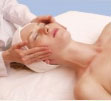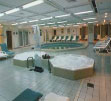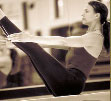
Manicure
A manicure is a cosmetic beauty cure for fingernails and hands. A manicure can treat just the hands, just the nails, or both. A standard manicure usually includes filing and shaping of the nails and the application of polish. Some specialty manicures, such as the French Manicure, may also be offered.
Treatments for hands usually
include soaking in a softening 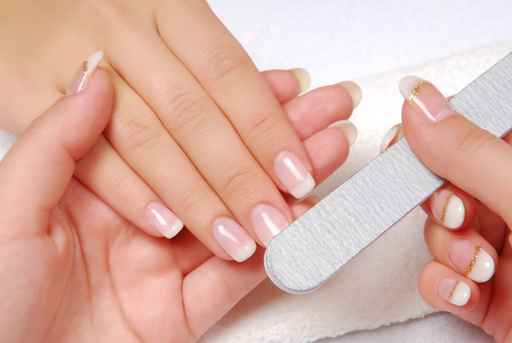 substance
and application of hand lotion. A similar treatment performed on
the feet is a pedicure. The word "manicure" comes from
the Latin manus, meaning "hand," and cura meaning "care".
substance
and application of hand lotion. A similar treatment performed on
the feet is a pedicure. The word "manicure" comes from
the Latin manus, meaning "hand," and cura meaning "care".
Various services for nails can be provided, such as the application of artificial nails such as nail tips, acrylics and man-made nail gels. A manicurist can also apply treatments to real nails, such as filing, polishing, and painting. Fancier manicures include painting pictures or designs on the nails or applying small decals or imitation jewels.
In many areas, manicurists are regulated and must be licensed. Because the skin is being manipulated and sometimes trimmed, and because there is a risk of infection when tools are used on multiple people, proper cleanliness is critical.
History
It began 5000 years ago. In India, henna was used for manicure.The term mendhi, used synonymously for henna, derives from the Sanskrit mehandika. Much of the modern revival of henna derives from its popularity in India.
Preparation
A manicurist prepares for a customer by ensuring that the working area and tools are germ-free and conveniently located. This might include sanitizing the working surface, such as a table top, placing clean metal implements into a jar with sanitize liquid, and having sanitized towels and new tools such as orange sticks and emery boards arranged neatly near the working area. Soaking liquids are not reused, and all water used can be boiled or otherwise sanitized. These preparations prevent the possible spread of disease. Proper lighting is also important.
Services Provided
There is a wide variety of services available from manicurists, and each manicurist might have a specialty. A reputable manicurist ensures that a client knows what services are available and explains the procedures and costs.
Cleaning
Normally a manicure starts with the washing and sanitizing of the subject's hands, preferably with jewelry removed. Old nail polish or artificial nails are removed with chemical nail polish remover. The hands can be cleaned with soap and hot water, or by scrubbing with a bath salt and rinsing with hot water. The salt scrub has the advantage of removing dead skin cells via scuff. The hands are then dried with a clean towel.
Fingernail Trimming :
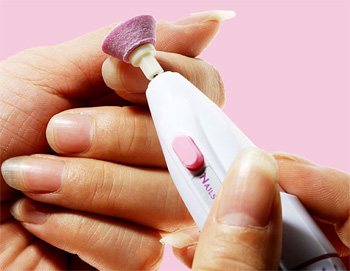
The fingernails are then trimmed and filed to the desired length and shape using fingernail file. Metal files can be used for rapid removal of nail material; however this can tension the nails. Professionally, fine glass files are preferred. Disposable two-sided emery boards can also be used. These are disposable paper boards coated with emery, an abrasive. Usually one side of the board is rougher than the other.
Proper filing technique starts with the file at the outer edge of the nail, moving towards the center. This is repeated from the other side of the nail to the center. The file should not be moved back and forth in a saw-like motion.
Cuticle Care :
Hands are then soaked in water to soften the skin, particularly the cuticles. If needed, a cream, oil, or chemical cuticle remover can also be applied to soften cuticles and detach them from the top of the fingernail. The cuticles are then pushed back with a cuticle pusher.
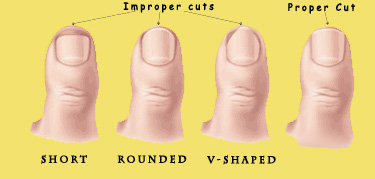
A cuticle pusher is simply a wooden stick with a flat end, sometimes wrapped in cotton. Metal cuticle pushers should be used with great care, as they can damage the fingernail matrix. Orangewood is the preferred material because of its softness.
Some manicurists offer to trim ragged cuticles with cuticle shears, but this varies by manicurist. Some believe that live cuticles should not be cut, because the cuticle acts as protection from bacterial infection. Dead, loose skin can be safely removed, however. Some customers prefer not to have their skin cut at all, even if it is dead. However, these strips of loose skin can become hangnails, which if present can end up ripping the skin, which can then lead to infection.
Nail Care :
Fingernails are then polished with a polishing board. A polishing board is a board made of hard foam, paper, or plastic. A softer foam layer is added to each side, and fine polishing surfaces are placed on the foam. One side is for the rough polish, and the other side is split into a finer polish and an ultra fine polish to make the nails shine.
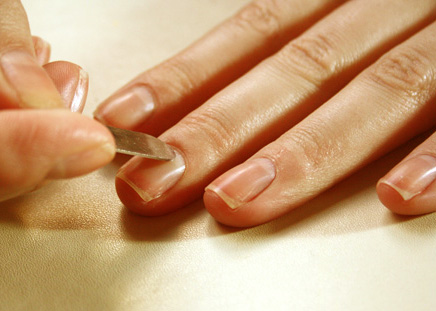
In most cases, the manicurist also applies at least one layer of nail polish, if only a simple clear polish. Some clear polish is meant to reinforce weak nails. The fingernails should be dry before sealing.
For colored nails, the procedure takes longer, as the manicurist must apply and allow to dry at least three layers: the (usually clear) base coat, the color coat, and the final (also usually clear) top coat. More layers can be applied, but the drying time increases with every coat.
Some manicurists are opposed to all nail polishes, including nail polish remover, because of the chemicals used in them. These can include ethyl acetate, toluene, formaldehyde, dibutyl phthalate (DBP), or other petroleum solvents.
Massage Procedures
A manicure is usually finished with a hand massage using hand lotion or oils. What follows is an outline of a typical hand-massage session.
To Begin :
Prepare customer's
forearms by removing any jewellery and pushing up long sleeves if necessary.
Stretch customer's
arms across table comfortably.
For Each Arm :
Apply a liberal
amount of massage lotion on customer's arm.
Work lotion
into arm.
Use rotary movements
beginning at the elbow going down towards the wrist. Slide up the arm.
Repeat three times. Flip arm and repeat on the
other side.
Wring arm going
up, slide down arm; repeat three times. Flip arm; repeat three times.
Hack arm up
and down arm both sides; repeat three times.
Criss-cross
around both sides of wrist.
Place customer's
arm upright, elbow on the table hold hands, and see-saw customer's hands/wrist
three times.
Begin at the
top of the wrist and use rotary motions going down the thumb and little
finger then go back to wrist, then rotate down
next two fingers. Repeat movements down middle finger, pilfering the finger tips as you slide off the finger.
Rotate and flex
each finger one at a time.
Ensure all lotion
applied has been absorbed by arm.
Paraffin Treatments
Sometimes the hands can be dipped in melted paraffin or wax. This is meant to impart heat to the hand for the purposes of soothing the skin and making it better able to absorb lotion, which is sometimes rubbed on the hand before submersion into the paraffin. The hand is usually dipped more than once to allow a thicker wax coat to form, making the coating stays warm for longer and less likely to break or tear impulsively. After the hands have been dipped in the wax, they are wrapped in either plastic or tin foil, then covered with cloth to retain warmth.
Hot Oil Manicure
A hot Oil Manicure is a specific type of manicure that cleans and neatens the cuticles and softens them with oil.





